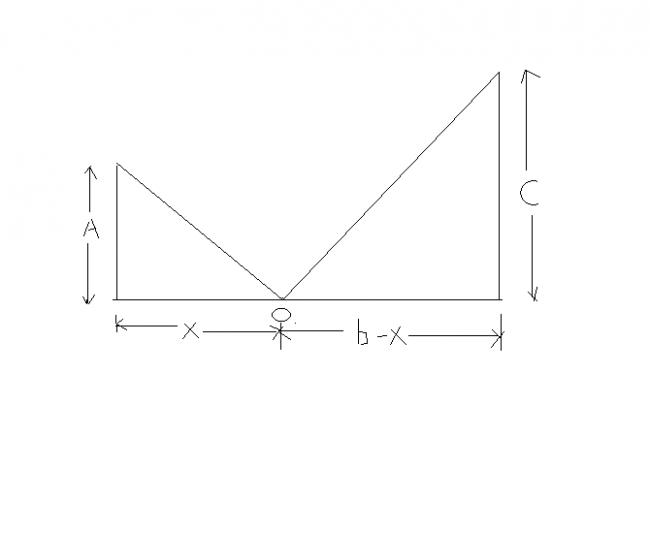If you know inequalities, this is the Minkowski inequality at work.
\sqrt{x^2+a^2} + \sqrt{(b-x)^2 + c^2} \ge \sqrt{b^2 + (a+c)^2} with equality when \frac{x}{b-x} = \frac{a}{c}
Consider a man standing at a point P at a distance a unit from the wall.
This man has to reach at a point Q (which is on the same side of the wall). Distance between P and Q, measured along a wall is b units, while the distance of Q from the wall is c units. The man has to touch the wall before arriving a point Q.
Locate the point on the wall that the man should before arriving at Q, so that the distance covered by him is the least.

let the man travel with speed v and let him touch the wall at o
total distance covered (D)= √(a2+x2) + √((b-x)2+c2)
total time taken by him would be = D/v....(1)
time taken by man would be least if he travels the least distance,therefore
differentiate(1)wrt to x to get the value of x corresponding to least time
This is a popular example to demonstrate how you can obtain minimum without using calculus:
Reflect the point Q across the wall so that now P and Q are on the opposite sides of the wall. Let the reflected point be Q' and O the point of intersection of PQ' and the wall.
Now consider any other point O' on the wall.
Its easy to see that PO' + O'Q = PO' + O'Q'
By triangle inequality, PO' + O'Q' > PQ'.
So to minimise the distance travelled, you must first go to the point O which is the intersection of wall and PQ'.
From simple geometry, the two angles are equal, so the equation is simply
\frac{x}{a} = \frac{b-x}{c}
yeah sir ..this is the best and quickest methood to reach the answer..[1][1]
If you know inequalities, this is the Minkowski inequality at work.
\sqrt{x^2+a^2} + \sqrt{(b-x)^2 + c^2} \ge \sqrt{b^2 + (a+c)^2} with equality when \frac{x}{b-x} = \frac{a}{c}